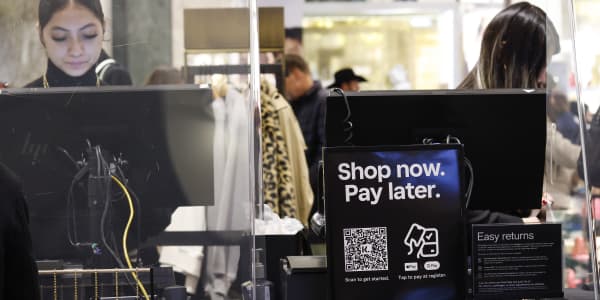It's the moment brick-and-mortar retailers have been dreading.
As shoppers shift a greater chunk of their spending toward the web, consumers for the first time this holiday will allocate an equal amount of their budgets toward online and physical stores.
While that shift should help boost traditional retailers' digital revenues, it will nonetheless help web-based companies extend their lead over physical stores and shopping centers — gobbling up more of their market share in the process.
It will also make it costlier for bricks-and-mortar players to effectively compete, as they swallow additional expenses related to shipping and logistics. Those investments are becoming ever more important as customers demand more from retailers, including shorter delivery windows for their online orders.
According to Deloitte's holiday survey, released Wednesday, shoppers plan to spend 47 percent of their budgets online, and 47 percent in stores. The remaining 6 percent will be put toward other channels, such as catalogs.
This is the first time consumers told Deloitte that their budgets would be split equally between the two largest channels. When the firm first asked the question two years ago, 52 percent of consumer spending was allocated toward stores, while just 40 percent went toward online.
Deloitte's 2016 results were based on a survey of more than 5,000 shoppers.
"Every retail location, every physical address, was down," said Rod Sides, who leads Deloitte's retail and distribution unit. "The consumer seems to have turned a corner and is as happy shopping online as they are in a store."
Source: Deloitte
That's not to say stores aren't important. A separate survey by the International Council of Shopping Centers trade group found that 39 percent of consumers plan to pick up their online orders in store — an increase of 7 percentage points last holiday. Roughly 80 percent of those shoppers said they'll make an additional purchase once they arrive at the store, according to ICSC.
The channels are becoming even more blurred, as an equal amount of shoppers plan to "webroom" and "showroom" this year. According to Accenture, 81 percent of consumers plan to search for holiday goods in stores, and then buy them online (a practice that's called showrooming). Meanwhile, 81 percent intend to browse online before swiping their credit card in a store, or "webrooming."
When shoppers conduct research before they head to the mall, those visits are more likely to end in a purchase. Yet that uptick in converting shoppers to buyers hasn't been enough to offset a continuous slide in traffic, Sides said.
"The big thing our clients are struggling with is foot traffic," he said.
To make their shops more of a destination, retailers are playing up the nostalgia of heading to the stores for the holidays. That includes the usual doorbuster deals and a greater emphasis on whimsical visual displays. Target, for example, is redesigning its seasonal shop-in-shops, and branding them under the "Wondershop" banner.
When consumers do place an order online, they're becoming harder to please. While 63 percent of shoppers last year considered three- to four-day shipping "fast," that number dropped to 42 percent this year, Deloitte found.
They're also less willing to pay for shipping. Shoppers on average said they'd pay an extra $1.50 for two-day shipping, down 90 cents from 2015. Two days is the maximum time Amazon Prime members have to wait for free delivery.
The National Retail Federation predicts retail sales will rise 3.6 percent this holiday, with revenue from non-store retailers growing as much as 10 percent. A separate forecast from eMarketer is calling for 17 percent online growth this holiday, with digital for the first time surpassing 10 percent of overall retail revenue.
Source: Deloitte




